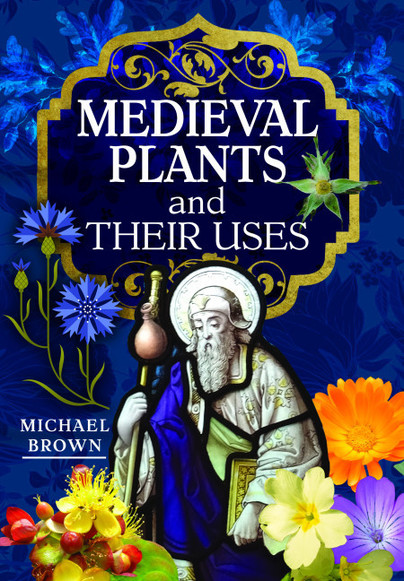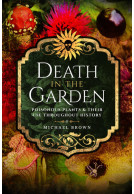Medieval Plants and their Uses (Hardback)
Imprint: White Owl
Pages: 184
Illustrations: 112 colour illustrations
ISBN: 9781526794581
Published: 6th March 2023
(click here for international delivery rates)
Need a currency converter? Check XE.com for live rates
| Other formats available - Buy the Hardback and get the eBook for £1.99! | Price |
|---|---|
| Medieval Plants and their Uses eBook (38.5 MB) Add to Basket | £6.99 |
Plants were an essential part of medieval life. Most people lived in houses made of wood and thatch, which often accidentally burned down when they cooked their food or huddled over wood fires to keep warm. People wore linen clothing dyed with plants. They drank ale, cider and wine as they danced to music played on wooden instruments. Beauty, love and seduction could all be made easier with a few herbal preparations. If you became ill, plants provided many of the cures. The unwary may have mistaken a poisonous plant for one that was good to eat, with fatal consequence. Others may have used the poisonous plant to remove an unwanted rival. Some plants had magical properties. The mysterious mandrake could kill anybody who tried to dig it up without taking the appropriate precautions. Demons could be summoned or dismissed by the aid of plants. The church used powerful incense to clean the air and induce a sense of religious euphoria.
This book is designed to give a broad introduction to the plants that were used during the medieval period. With many colourful photos, a list of plants that were available and some original medieval recipes to try, you can set out on an adventure to explore the wonderful world of medieval plants.
This book is really interesting. I find it very useful to be able to look up specific plants when I need to. This is the perfect book for someone interested both in plants, and in the medieval period more generally.
NetGalley, Maria Düring
Rating: 5 out of 5 stars
NetGalley, Joanna Arman
A fascinating little book on plans and how they were used in the Medieval period. The use of some has not changed much at all- liquorice, honey and other things are still used for throat problems and colds. Other plants were used for personal health and grooming: no Medieval people didn’t stink all the time and they used plant-based substances to make themselves and their clothing smell good.
Other plants are barely known, or little used today- and their Medieval use was dubious to say that least. Usually when it involved medicine. The “don’t try this at home” warning was necessary a couple of times.
However, the book doesn’t just cover the weird and wonderful medical uses of plants, it also covers culinary uses with plants which were popular and can still be added to recipes. Ergo fruits have their own chapter: including medlars. These are wild apples (they look like crab apples) which are little used today but were a staple of the Medieval diet. That part was especially interesting as I recently heard a video on medlars, when they grow and how best to eat them.
The book is crammed full of illustrations and photos of the plants in question: which is actually very useful for people like me. Although I have lived in the country most of my life, I don’t recognize most plants on sight.
The author peppered the book with recipes from the period- but also a couple for medlar and fruit-based dishes which can be tried, as well as instructions on how to make ointments and medicinal syrups.
This part of the book is what made it stand out for me: its not just interesting from an academic perspective. Its not just another history book: you can make use of some of the things that it mentions. Finding the plants, cooking with them, or trying to make a whistle from a willow branch.
Rating: 5 out of 5 stars
NetGalley, AREVIK HEBOYAN
This was a fascinating read for someone who has basically 0 knowledge of the subject and wouldn't normally consider it an interesting read. But it did capture my interest and the research that went into the book is just impeccable.
As featured in
The Countryman
I studied Medieval history during my undergrad and graduate studies so I tend to pick up related titles to the field. This was an interesting look into an area of the time period I had not previously spent time. I enjoyed the content and the cover is stunning.
NetGalley, Stephanie Bentivegna
I studied medieval history for part of my undergrad career, so I love checking out new books centered around the time period. The topic of plants definitely wasn’t something we got into very deeply at college, so this was a cool read! Very accessible and quick.
NetGalley, Terri Bonney
A well written history of plants and their uses.
NetGalley, Victoria Chant
I will be buying this for my sister - definitely recommend if you are interested in this type of thing.
An informative and easy to follow book about plants and how they were used in Middle Age.
NetGalley, Anna Maria Giacomasso
Well researched and a fast read.
Recommended.
I’m so glad I’ve chosen and read this book because it helped me immensely for one of my classes. I even recommended it to my lecturer. Great source of info.
NetGalley, amara moon
Brown provides an accessible and fascinating insight into the uses of medieval plants.
NetGalley, Robin Mason
Rating: 5 out of 5 stars
NetGalley, Annie Buchanan
This is a well presented and layman accessible monograph on the historical importance of plants and agriculture to medieval society. The author is engaged and very knowledgeable, and that enthusiasm (and expertise) comes through clearly in the text.
The book is arranged thematically: medieval vegetables, fruits & nuts, grains, plants & medicine, symbolism & superstition, magical & mysterious, love seduction & beauty, childbirth babies & nursemaids, clothing laundry & household tips, dyes inks & paints, animal health care, harvesting & preserving, fun things to do, and and plant lists with charts in alphabetical order showing botanical & common names for various types of plants including abbreviated uses and historical names in the literature from the medieval period.
The book is enhanced throughout with colour photographs of subject plants as well as diagrams and facsimiles of period illustrations.
Five stars. A valuable and interesting read. It would make a good choice for public or school library acquisition, home use, smallholding, allotment garden library, historical re-enactors, and similar.
This book is a very good introduction to the world of medieval plants and their uses in kitchen, medicine and daily life. If you're new to the topic, Michael Brown will offer you a broad insight. Especially interesting are the recipes, which show how different our tastes are today.
NetGalley, Bettina Bergmann
This is a great book for anyone interested in herblore or the medieval era.
NetGalley, Morgan Frazier
Beautifully and profusely illustrated throughout with full color photography, "Medieval Plants and their Uses" is an extraordinarily informative and invaluable contribution to personal, professional, community, and academic library Medieval Studies collections in general, and Medieval Medicine curriculum studies reading lists in particular.
Midwest Book Review
Read the full review here
As an avid (although amateur) gardener, I loved this book! I am a student of history and constantly looking for connections between our past and our present. Many of these plants are herbs, flowers, and fruits that I recognized. The photos are beautiful. Each chapter covers a different area of use, and as the book progresses you find that the flowers and herbs we take for granted today had great medicinal, cultural, and symbolic uses for medieval Europeans. An excellent read, or an interesting flip through if you can't fully commit.
NetGalley, Anna Wooliver Phillips
I loved learning about plants I’ve never heard of, including several vegetables that are no longer widely cultivated as the easier to grow and cook potatoes have taken their place. It was also interesting learning how medieval people may have dealt with things like chapped lips or dying hair. Another fun tip was to chew licorise for a clear voice, the way Roman orators did.
NetGalley, Jessica Strider
Rating: 5 out of 5 stars
NetGalley, Brenda Carleton
If everyone in the medieval age walked around holding yarrow to squash fears, chewed on oregano for nearly all ails, made ink for writing, crafted horsetails for brushes and varied their pottage for every meal (love the monk quip!) surely there would have been no mental or physical health issues at all. After all, very few plants and their parts were not used. But. There is so much more to life...and this book...than that. Cosmetics, dyes, poultices, sweetener (sweet cicely...honey only used by the wealthy), dental hygiene, instruments, hair loss prevention, symbolism, seasoning and cough relief are other uses.
Not only are there loads of illuminative photographs and illustrations, there are recipes and projects to make yourself. The one I want to try in particular is the mustard balls, though not everyone could procure the ingredients to make the Relief of Earache recipe. "Worms" were blamed for many health problems. Poor kids must have been terrified of the thought of worms in their gums! I learned about Gromwell seeds, that garden peas were stored in their shells until use, that inexpensive oyster shells were used for melting ingredients for medications and that rush was for candles which was new to me. Animals were cared for (their bread and butter) and as humans were said to have four humours. Only the wealthy could afford to have plants purely for pleasure.
Author Michael Brown has researched this topic well...and it shows. The variety of topics is brilliant and the writing easy and enjoyable.
My sincere thank you to Pen & Sword and NetGalley for the privilege of reading this splendid book, one I recommend to everyone fascinated with the Medieval Age, especially everyday life and plant uses.
Rating: 5 out of 5 stars
NetGalley, AJ Sefton
So almond milk isn't a modern day trendy thing after all! Just one of the many fascinating things I learned from this wonderful book.
For anyone interested in food, gardening or Medieval lifestyle, this is a essential addition to any collection. Sits neatly alongside Michael Brown's book A Guide to Medieval Gardens as it explains the uses of many of the plants mentioned in the gardens. There are plenty of full colour photographs of plants and Medieval scripts to illustrate the plants and fruits discussed as well as coloured boxes containing recipes from the times - including how to make almond milk. The language is easy to follow so accessible to everyone not just historians, botanists and chefs.
Mythology, folklore and the history surrounding the uses (and the non-use) of certain plants is very interesting, such as warning not to sit under walnut trees because of the noxious fumes they gave out. However, the patterns of the walnut indicated that they would be good for the head. Makes sense. There are discrete chapters about Symbolism and Superstition, and Magical and Mysterious as well as practical uses such as clothing, beauty, animal care, childbirth and medicinal. Some great tips too.
The book can be used as a reference because of the way the chapters and information are organised, but it's far too ornate for that. Alongside the photography, the borders are attractively designed with illustrations of plants making this a very pleasant book indeed.
Rating: 5 out of 5 stars
NetGalley, MEGAN FISCUS
Medieval Plants and Their Uses gives the reader a sense of what life was like in the middle ages through cultivation of plants for various purposes. The book has a lot of excellent photographs that coincide with history, lore, and recipes that would have been used at the time for everything from food to medicine. It is a very quick read, because Michael Brown writes in a very conversational way that is both informative and shows an obvious passion for the time period and plants as well. As Brown points out in the book, there has been a transition away from the naturopathic ways of the past, but as we start to have a resurgence in interest in growing our own crops for medicine and food, we would do well to be informed and make sure that we aren't blindly re-adopting ways that are best left behind.
Rating: 5 out of 5 stars
NetGalley, Shirley Andrade
Definitely A Great Reference Book
Very informative on the history of medieval plants and their uses, especially, the old traditional way of countering the unfortunate side effect of flatulence that so many of us get when we eat bean. It is believed that cooking bean with the evergreen herb Winter Savory, would counter the flatulence that one may experience.
I love the many recipes provided and the enormous amount of health remedies used throughout the medieval period; such as nightshade, hemlo, henbane, mandrake and opium poppy. These herbs were poisonous and very deadly, if taken in large quantities. This book contains herbal remedies from urinary problems, stings and bites, haemorrhoids (commonly known as piles) to problems dealing with the head, eyes, ears, skin, and may other common ailments and cures.
While it is written that herbs have countless medicinal benefits, they are also said to be magical and mysterious. In medieval times, plants were not exempt from the influences of being both good and evil. Some plants are poisonous and have been used to destroy life and other the other hand to save a life.
I feel this book is a great reference source for anyone dealing with medieval plants and their uses. Not only are the various plants listed throughout this book, but general guidelines are provided for harvesting and preserving plant material.
I truly enjoyed reading and being made aware of the many herbs and how they can be used to benefit one’s life, when used properly. I highly recommend to like individuals.
Rating: 5 out of 5 stars
NetGalley, Sophie Crane
Oh, my goodness, this is simply beautiful. It has an overview of each plant rather than loads of detail, but it is the sort of book which makes you feel enriched just to have it in your possession. Much larger than I expected, and I actually want to stroke it. The Photos & illustrations are gorgeous and beautifully laid out, the information interesting and very readable.
I love this type of book that takes a subject and gives you so much information about it in depth that you learn everything you wanted to know and everything that you didn’t know you wanted to know!
NetGalley, Fern Adams
The title very much explains what this book is about; plants and how they were used during medieval times. Split into chapters covering topics such as medicinal uses, folklore, practical uses in the home, and food and drink the subject is covered comprehensively. I especially enjoyed learning about beliefs in medicine of why each plant was used to cure certain illnesses. In many ways we have forgotten a lot of the knowledge, though equally it does mean we don’t use some of the horrible remedies either! The book finishes with a couple of practical things you can try including making a flower crown and instruments.
I really enjoyed this and found the author got the writing tone just right so that while it remained factual and informative it didn’t take on a dry, textbook style form either. I’ll definitely be reading it again in the future.
Rating: 5 out of 5 stars
NetGalley, Kara Race-Moore
A simply gorgeous book for gardeners who love British medieval history, the book is stuffed full of gorgeous color photos of plants in bloom, and many facts and history on the cultivation and use of these plants that have been around for centuries, still growing in humble English gardens just as they did six centuries ago.
Rating: 5 out of 5 stars
NetGalley, Peter Thorburn
As a biology teacher I’m always interested in improving my botanical knowledge (not my strongest subject area). This book fulfils that and gives lots to bring to future lessons. It also gives some ancient recipes, which are interesting. Finally I’m also interested in how plants have for so long been part of medicinal treatments long before the particular compounds within them were known. I enjoyed reading all the topic areas in the book. I can see myself coming back to this many times.
When I review a book, I spend a few days foregoing all other books and focus on the book at hand. For me, the reason is simple: I want to give each book the consideration that authors deserve. But before I discuss Michael Brown’s work, though, I do need to mention the book’s graphic designer(s).
NetGalley, Matal Baker
I don’t know who designed the book, only that SJmagic Design Services of India was responsible for the typesetting. And let me tell you, they did a beautiful job with the type. The author included his own color photographs, with many of them being full-page images. But whoever was responsible for the actual graphic design of the book—the placement of photographs, the design of the plants next to the page numbers, and etc.—did a fantastic job. The minute that I opened it, I said to myself: Now THIS is what I expect from a non-fiction book on herbs and plants. All of the pages are 100% full color, and it is this color—along with the small plant images sitting next to the page numbers—that impresses readers and sells books. This made me read on and on.
The author, Michael Brown, is a really good, solid writer. He wrote about plants, herbs, and trees that were used during the medieval era interspersed with fascinating tales of medieval life, along with cultural bits about what the plant was historically used for. But Brown didn’t limit his discussion to just herbs, but also trees, bushes, vegetables, fruit, nuts, and grains like spelt, wheat, and barley. He also included information that a lot of people don’t consider when they think about medieval life. For example, that the average agricultural worker required a staggering 5,000 calories per day just to survive! (Pp. 34).
I really love how Brown wove in writing from the medieval era, especially at various times when he provided snippets from Chaucer’s “Canterbury Tales.” When the author did this, he revealed how important his book is, because in order to really understand Chaucer’s writing, one needs to fully understand the world in which he lived, and this includes both food ways and herbal lore, much of which is included in the Tales.
The author includes information on both Arab and African herbalists, but focuses primarily on how medieval British used plants and herbs. But this was not surprising given the British love of gardening. In fact, the only place in the world where gardeners are superstars and national heroes is in the United Kingdom (e.g., think of Monty Don and the BBC half-century-long series ‘Gardener’s World’).
Brown didn’t limit his text to just describing the plants and how they were used, but even discussed the 4 humours and the Doctrine of Signatures in detail in an easy-to-read, non-academic way. The author brilliantly included lists of herbs, plants, trees, and etc., and included the modern common names, botanical (scientific) names, their uses, and also the medieval names and spellings (I would have never guessed that the medieval British called French Lavender ‘stickadove’!). With the inclusion of these charts, the author guarantees that this book will become an important reference to anyone doing research into old archives or reading old documents or old books...
Brown did a fantastic job writing this book, and the publishers did equally well by recruiting talented graphic designer(s). I recommend this book not only to people interested in gardening and natural cures, but also to anyone interested in history and particularly to those who are reading older texts that were written during the medieval era.
Rating: 5 out of 5 stars
NetGalley, Patrick Carmen
This book is fascinating and really relevant to anyone with an interest in herbs or home medical techniques. The pictures are superb and easy to tell what is being described as the leaves are shown along with the fruits. I never knew that the old world had such a large understanding of herbs and their usages. My favorite part of this book beside the many recipes and ways to use the plants was the explanation about the Doctrine of Signatures. I actually understood it and have used it to look at nearby herbs and weeds and discover what they are good for. Lots of common sense in this books teachings as its important to be sure in what you are doing with the plants you discover. This book is fun and really informative!
Rating: 5 out of 5 stars
NetGalley, Heather Michael
This was a very fasinating book! I really really enjoyed reading a lot! The author did a great job in the research and ideas on how to use herbs. If you find herbs and how they used them throughout history, you might want to check this book out! I will be reading it over and over.
Rating: 5 out of 5 stars
NetGalley, Michelle Coates
Love these sorts of informative books…… Plants were an essential part of medieval life. Most people lived in houses made of wood and thatch, which often accidentally burned down when they cooked their food or huddled over wood fires to keep warm. People wore linen clothing dyed with plants. They drank ale, cider and wine as they danced to music played on wooden instruments. Beauty, love and seduction could all be made easier with a few herbal preparations. If you became ill, plants provided many of the cures. The unwary may have mistaken a poisonous plant for one that was good to eat, with fatal consequence. Others may have used the poisonous plant to remove an unwanted rival. Some plants had magical properties. The mysterious mandrake could kill anybody who tried to dig it up without taking the appropriate precautions. Demons could be summoned or dismissed by the aid of plants. The church used powerful incense to clean the air and induce a sense of religious euphoria.
Rating: 5 out of 5 stars
NetGalley, Caroline Palmer
Fantastically interesting for lovers of plants and history! Not only is there a description of the plants and how they were used, but also gives recipes on how to make historic dishes.
This was a fun, informative read!
NetGalley, Becca Johnson
I enjoyed learning not only about how people used plants in the medieval period, but also what they believed about them. There were some really interesting, sometimes entertaining, facts throughout the whole book. And being someone who finds language fascinating, I loved learning the history of some names and words... I really enjoyed this book. It covered a lot of topics and didn't feel like a dry list of facts. It had a good balance of stories, information, and fun facts!
Rating: 5 out of 5 stars
NetGalley, Cheryl Purnell
A guide to how plants, vegetables, fruits, grains etc were used for food and medicine amongst other things.
This is a very well researched and written book, I find it fascinating how many plants were used as daily routine, it was second nature to turn to what grew around them to feed and heal, I also find it sad how so many are dismissed as weeds or garden flowers in our modern times.
As an amateur herbalist, I love the feeling of picking herbs and plants I have grown, whether to eat or heal and this book renewed my fascination with it but also gave me ideas for what to forage and grow in the future.
About Michael Brown
Michael has been interested in history and gardening for as long as he can remember.
He spent his childhood building camps, cooking (well, actually burning food) over open fires, making bows and arrows and using cricket stumps for swords - he still finds cricket very boring!
Michael researched and designed the medieval gardens at the Prebendal Manor, Nassington, experimenting with medieval gardening methods and the uses of plants.
Michael lectures on early gardens, gardening and plants and has an MA in Garden History.
A History of Herbalism Cure, Cook and Conjure (Hardback)
Food historian Emma Kay tells the story of our centuries-old relationship with herbs. From herbalists of old to contemporary cooking, this book reveals the magical and medicinal properties of your favourite plants in colourful, compelling detail. At one time, every village in Britain had a herbalist. A History of Herbalism investigates the lives of women and men who used herbs to administer treatment and knew the benefit of each. Meet Dr Richard Shephard of Preston, who cultivated angelica on his estate in the eighteenth century for the sick and injured; or Nicholas Culpeper, a botanist who catalogued…
By Emma KayClick here to buy both titles for £45.00


















